At Cinema Ritrovata 2016, a programme section is focused on director MARIO SOLDATI, AN ECLECTIC MAN AT CINECITTÀ. He often worked with Massimo Serato (1916-1989), like for the historical drama Piccolo mondo antico/Little Old Fashioned World (Mario Soldati, 1941). The Italian film actor had a career spanning over 40 years with more than 140 films. Serato was the virile hero of dozens of Peplum films and Spaghetti Westerns in Italy, but he also played roles in major international films.
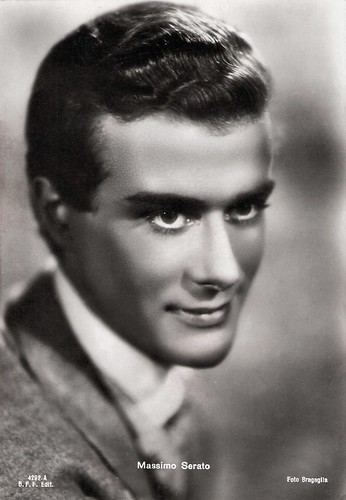
Italian postcard by B.F.F. Edit., no. 4242-A. Photo: Bragaglia.
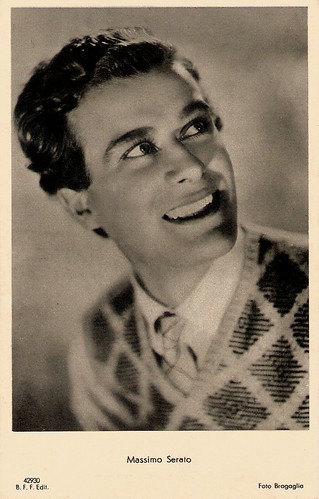
Italian postcard by B.F.F. Edit., no. 4293. Photo: Bragaglia.
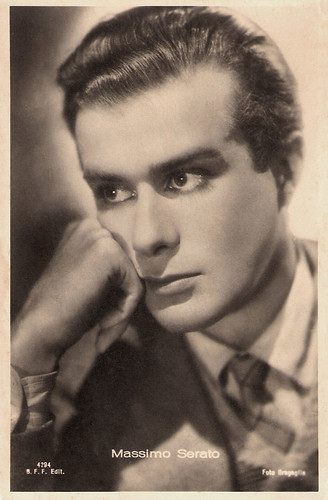
Italian postcard by B.F.F. Edit., no. 4294. Photo: Bragaglia.

Italian postcard by B.F.F. Edit., no. 4587-A. Photo: E.N.I.C.

Italian postcard by A. Scarmaglia Ed. Roma (ASER). Photo: Ciolfi, Roma.
Massimo Serato was born as Giuseppe Segato in 1916, in Oderzo, Italy. He abandoned his university studies, to attend the Centro Sperimentale, the Italian Film Academy in Rome.
He made his film debut in Inventiamo l'amore/Let’s Invent Love (Camillo Mastrocinque, 1938). His breakthrough was the historical drama Piccolo mondo antico/Little Old Fashioned World (Mario Soldati, 1941) with Alida Valli, about the Risorgimento, the unification of Italy.
From the early 1940s on, the tall, blonde and photogenic actor starred in films like L'uomo venuto dal mare/Man of the Sea (Belisario L. Randone, Roberto de Ribón, 1942), Giacomo l'idealista/Giacomo the Idealist (Alberto Lattuada, 1943), Le sorelle Materassi/The materassi Sisters (Ferdinando Maria Poggioli, 1944) and Quartieri alti/In High Places (Mario Soldati, 1943-1945).
After the war, he appeared in such Neorealist films like Il sole sorge ancora/Outcry (Aldo Vergano, 1946), Domenica D'Agosto/Sunday in August (Luciano Emmer, 1949) and the tragedy Febbre di vivere/Eager to Live (Claudio Gora, 1953) with Marina Berti.
He also appeared as the athletic hero in popular entertainment like La Traviata/The Lost One (Carmine Gallone, 1949) an adaptation of the opera of Giuseppe Verdi, the adventure Il Ladro di Venezia/The Thief of Venice (John Brahm, 1950) opposite Maria Montez in her last role, the historical drama Lucrece Borgia/Lucretia Borgia (Christian-Jacque, 1953) as the handsome lover of sex symbol Martine Carol, and L'Amante di Paride/The Loves of Three Queens (Marc Allégret, Edgar G. Ullmer, 1954) as one of the three loves of Hedy Lamarr.
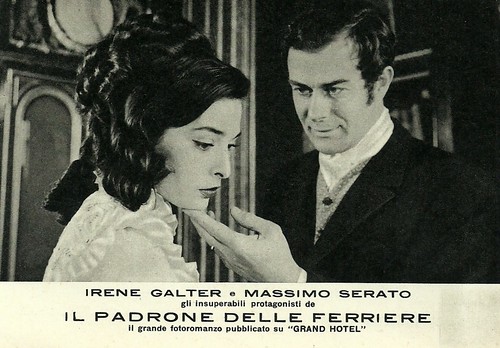
Italian postcard for the 'fotoromanzo' Il padrone delle ferriere, starring Massimo Serato and Irene Galter, published in 'Grand Hotel' in 1960. It was based on Georges Ohnet's famous novel Le maitre des forges.
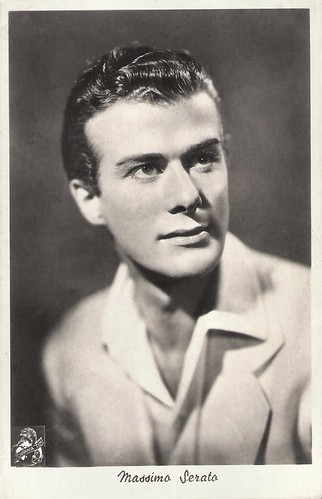
Italian postcard by Alterocca, Terni, no. 6617, 1941. Photo: Ferri / Sovrania Films.
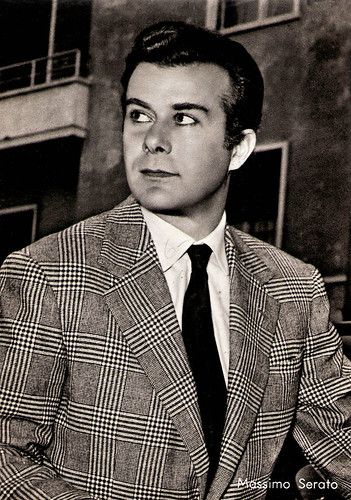
Italian postcard by Bromostampa, Milano, no. 145.
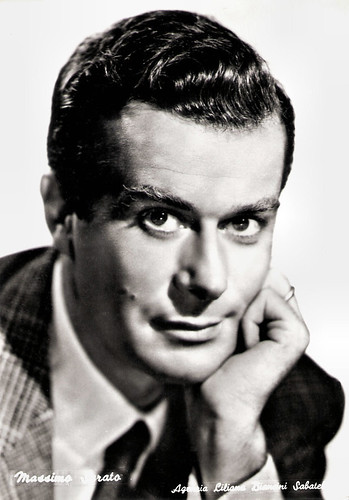
Italian postcard by Bromofoto, Milano, no. 1461. Photo: Agencia Liliana Biancini Sabatella.
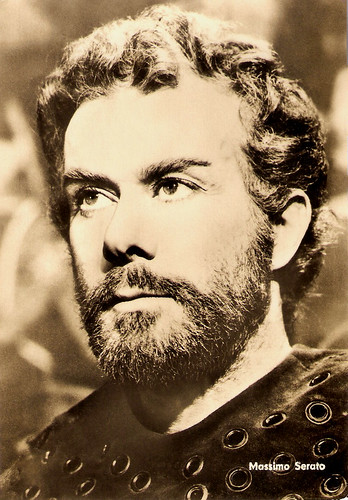
East-German postcard by VEB Progress Filmvertrieb, Berlin., no. 140/69. Retail price: 0,20 M. Photo: publicity still for El Cid (Anthony Mann, 1961).
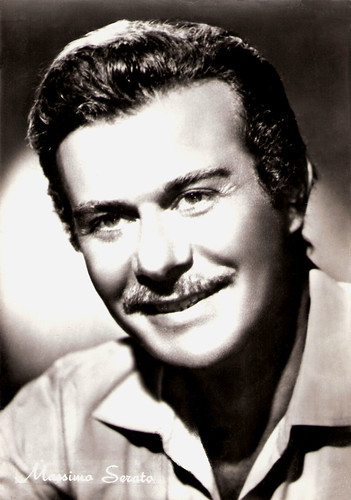
Italian postcard by Rotalfoto, Milano, no. 256. Photo: Manuelli, Tirrenia.
Massimo Serrato demonstrated a versatile talent during his long career. He starred as the hero or as the bad guy in the Peplum (sword and sandal epics) as well as in the Giallo (the typical Italian thriller), in Spaghetti westerns and in comedies. He also appeared in Fotoromanzi, the popular Italian photo booklets.
Serato eased gracefully into robust character roles in the late 1950s, like in the classic Il Grido/The Cry (Michelangelo Antonioni, 1957).
He appeared in international films like The Naked Maja (Henry Koster, Mario Russo, 1959) starring Ava Gardner, and the extravagant blockbusters El Cid (Anthony Mann, 1961) and 55 Days at Peking (Nicholas Ray, 1963) - both starring Charlton Heston.
In Italy he appeared in the Peplums David e Golia/David and Goliath (Ferdinando Baldi, Richard Pottier, 1960) with Orson Welles and Gli amori di Ercole/The Loves of Hercules (Carlo Ludovico Bragaglia, 1960) featuring husband and wife Mickey Hargitay and Jayne Mansfield.
Other interesting genre films in which he appeared were the SF-comedy La decima vittima/The Tenth Victim (Elio Petri, 1965) with Marcello Mastroianni, the Sexploitation Camille 2000 (Radley Metzger, 1969) as the father of Nino Castelnuovo, and the Spaghetti Western Anda muchacho, spara!/Dead Men Ride (Aldo Florio, 1971) starring Fabio Testi.
A highlight was the beautifully restrained psychological thriller Don't Look Now (Nicholas Roeg, 1973) with Julie Christie.
His final film part was in the James Hadley Chase adaptation L'avvoltoio può attendere/The Vulture Can Wait (Gian Pietro Calasso, 1991) starring Donald Pleasence.
Massimo Serato died in 1989, in Rome, Italy. He had a son, Cellino (1942 or 1943), from an affair with actress Anna Magnani, with whom he later appeared in Camicie rosse/Anita Garibaldi (Goffredo Alessandrini, 1951). Cellino, called Luca Magnani, contracted polio at an early age, and he would spent the rest of his life in a wheelchair.
Scene from Piccolo mondo antico (1941). Source: IPdT-Community (YouTube).
Trailer Il Grido (1957). Source: Danios 12345 (YouTube).
Long scene from Afrodite Dea Dell'Amore/Aphrodite, Goddess of Love (1958). Source: PEPLUMTV (YouTube).
Italian trailer for La Decima Vittima/The Tenth Victim (1965). Source: Neverlando 74 (YouTube).
Theatrical Trailer Don't Look Now (1973). Source: TheGePeU (YouTube).
Sources: Hal Erickson (AllMovie), Wikipedia, and IMDb.

Italian postcard by B.F.F. Edit., no. 4242-A. Photo: Bragaglia.

Italian postcard by B.F.F. Edit., no. 4293. Photo: Bragaglia.

Italian postcard by B.F.F. Edit., no. 4294. Photo: Bragaglia.

Italian postcard by B.F.F. Edit., no. 4587-A. Photo: E.N.I.C.

Italian postcard by A. Scarmaglia Ed. Roma (ASER). Photo: Ciolfi, Roma.
Tall, Blonde and Photogenic
Massimo Serato was born as Giuseppe Segato in 1916, in Oderzo, Italy. He abandoned his university studies, to attend the Centro Sperimentale, the Italian Film Academy in Rome.
He made his film debut in Inventiamo l'amore/Let’s Invent Love (Camillo Mastrocinque, 1938). His breakthrough was the historical drama Piccolo mondo antico/Little Old Fashioned World (Mario Soldati, 1941) with Alida Valli, about the Risorgimento, the unification of Italy.
From the early 1940s on, the tall, blonde and photogenic actor starred in films like L'uomo venuto dal mare/Man of the Sea (Belisario L. Randone, Roberto de Ribón, 1942), Giacomo l'idealista/Giacomo the Idealist (Alberto Lattuada, 1943), Le sorelle Materassi/The materassi Sisters (Ferdinando Maria Poggioli, 1944) and Quartieri alti/In High Places (Mario Soldati, 1943-1945).
After the war, he appeared in such Neorealist films like Il sole sorge ancora/Outcry (Aldo Vergano, 1946), Domenica D'Agosto/Sunday in August (Luciano Emmer, 1949) and the tragedy Febbre di vivere/Eager to Live (Claudio Gora, 1953) with Marina Berti.
He also appeared as the athletic hero in popular entertainment like La Traviata/The Lost One (Carmine Gallone, 1949) an adaptation of the opera of Giuseppe Verdi, the adventure Il Ladro di Venezia/The Thief of Venice (John Brahm, 1950) opposite Maria Montez in her last role, the historical drama Lucrece Borgia/Lucretia Borgia (Christian-Jacque, 1953) as the handsome lover of sex symbol Martine Carol, and L'Amante di Paride/The Loves of Three Queens (Marc Allégret, Edgar G. Ullmer, 1954) as one of the three loves of Hedy Lamarr.

Italian postcard for the 'fotoromanzo' Il padrone delle ferriere, starring Massimo Serato and Irene Galter, published in 'Grand Hotel' in 1960. It was based on Georges Ohnet's famous novel Le maitre des forges.

Italian postcard by Alterocca, Terni, no. 6617, 1941. Photo: Ferri / Sovrania Films.

Italian postcard by Bromostampa, Milano, no. 145.

Italian postcard by Bromofoto, Milano, no. 1461. Photo: Agencia Liliana Biancini Sabatella.

East-German postcard by VEB Progress Filmvertrieb, Berlin., no. 140/69. Retail price: 0,20 M. Photo: publicity still for El Cid (Anthony Mann, 1961).

Italian postcard by Rotalfoto, Milano, no. 256. Photo: Manuelli, Tirrenia.
Versatile Talent
Massimo Serrato demonstrated a versatile talent during his long career. He starred as the hero or as the bad guy in the Peplum (sword and sandal epics) as well as in the Giallo (the typical Italian thriller), in Spaghetti westerns and in comedies. He also appeared in Fotoromanzi, the popular Italian photo booklets.
Serato eased gracefully into robust character roles in the late 1950s, like in the classic Il Grido/The Cry (Michelangelo Antonioni, 1957).
He appeared in international films like The Naked Maja (Henry Koster, Mario Russo, 1959) starring Ava Gardner, and the extravagant blockbusters El Cid (Anthony Mann, 1961) and 55 Days at Peking (Nicholas Ray, 1963) - both starring Charlton Heston.
In Italy he appeared in the Peplums David e Golia/David and Goliath (Ferdinando Baldi, Richard Pottier, 1960) with Orson Welles and Gli amori di Ercole/The Loves of Hercules (Carlo Ludovico Bragaglia, 1960) featuring husband and wife Mickey Hargitay and Jayne Mansfield.
Other interesting genre films in which he appeared were the SF-comedy La decima vittima/The Tenth Victim (Elio Petri, 1965) with Marcello Mastroianni, the Sexploitation Camille 2000 (Radley Metzger, 1969) as the father of Nino Castelnuovo, and the Spaghetti Western Anda muchacho, spara!/Dead Men Ride (Aldo Florio, 1971) starring Fabio Testi.
A highlight was the beautifully restrained psychological thriller Don't Look Now (Nicholas Roeg, 1973) with Julie Christie.
His final film part was in the James Hadley Chase adaptation L'avvoltoio può attendere/The Vulture Can Wait (Gian Pietro Calasso, 1991) starring Donald Pleasence.
Massimo Serato died in 1989, in Rome, Italy. He had a son, Cellino (1942 or 1943), from an affair with actress Anna Magnani, with whom he later appeared in Camicie rosse/Anita Garibaldi (Goffredo Alessandrini, 1951). Cellino, called Luca Magnani, contracted polio at an early age, and he would spent the rest of his life in a wheelchair.
Scene from Piccolo mondo antico (1941). Source: IPdT-Community (YouTube).
Trailer Il Grido (1957). Source: Danios 12345 (YouTube).
Long scene from Afrodite Dea Dell'Amore/Aphrodite, Goddess of Love (1958). Source: PEPLUMTV (YouTube).
Italian trailer for La Decima Vittima/The Tenth Victim (1965). Source: Neverlando 74 (YouTube).
Theatrical Trailer Don't Look Now (1973). Source: TheGePeU (YouTube).
Sources: Hal Erickson (AllMovie), Wikipedia, and IMDb.
No comments:
Post a Comment